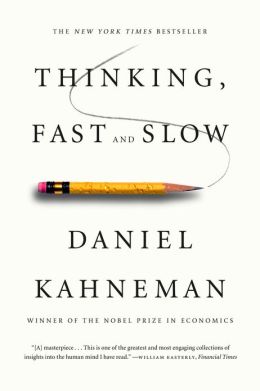Thinking, Fast and SlowDaniel Kahneman (2011)

Thinking, Fast and Slow reminded me that our personal performance hinges on the ability to identify and understand errors of judgment and choice. Kahneman emphasizes the need to develop a richer and more precise vocabulary for thinking and talking about the thinking mind. Reading his book brought me face-to-face with a question of import I had never confronted before: How does a brain trained to think fast answer difficult questions? Kahneman’s revealing reply: Faced with a difficult question, your brain quickly diverts itself to other related questions that it can answer more quickly. So we often answer the easier question that we have substituted … without even noticing our act of substitution. Kahneman’s insight has moved me to wonder about the attitude we refer to as “openmindedness”. How often do we engage a new idea with an “openmindedness” that leads to nothing more than a product of fast brain substitution? And I wonder just how often do we productively engage new ideas with a brute openmindedness — the kind of genuine, mental wrestling with the difficult and the unfamiliar that actually positions us to change our beliefs?
- David Waters
Description from front flap of Thinking, Fast and Slow
DANIEL KAHNEMAN, recipient of the Nobel Prize in Economic Sciences for his seminal work in psychology that challenged the rational model of judgment and decision making, is one of our most important thinkers. His ideas have had a profound and widely regarded impact on many fields — including economics, medicine, and politics — but until now, he has never brought together his many years of research and thinking in one book.In the highly anticipated Thinking, Fast and Slow, Kahneman takes us on a groundbreaking tour of the mind and explains the two systems that drive the way we think. System 1 is fast, intuitive, and emotional; System 2 is slower, more deliberative, and more logical. Kahneman exposes the extraordinary capabilities — and also the faults and biases — of fast thinking, and reveals the pervasive influence of intuitive impressions on our thoughts and behavior. The impact of loss aversion and overconfidence on corporate strategies, the difficulties of predicting what will make us happy in the future, the challenges of properly framing risks at work and at home, the profound effect of cognitive biases on everything from playing the stock market to planning the next vacation — each of these can be understood only by knowing how the two systems shape our judgments and decisions.Engaging the reader in a lively conversation about how we think, Kahneman reveals where we can and cannot trust our intuitions and how we can tap into the benefits of slow thinking. He offers practical and enlightening insights into how choices are made in both our business and our personal lives — and how we can use different techniques to guard against the mental glitches that often get us into trouble. Thinking, Fast and Slow will transform the way you think about thinking.
